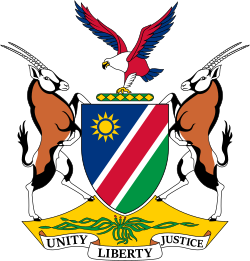 |
|---|
The government of Namibia consists of the executive, the legislative and the judiciary branches. The Cabinet is the executive organ of government, implementing the laws of the country. It consists of the president, the prime minister and his deputy, as well as the ministers of the Cabinet of Namibia. The legislative organs of government are the National Council and the National Assembly. They make the laws of the country. The judiciary organs of government are the courts. The highest court of Namibia is the Supreme Court. There are also the high courts and lower courts. [1]
Contents
- Executive branch of government
- Government organisations and state-owned enterprises
- Traditional leadership
- References
- External links
The Namibian government is partly centralised and partly regional. In the executive branch, central government consists of ministries, offices and agencies, whereas regional government consists of regional councils, and constituencies within these. [1] The legislation is centralised in the lower house (National Assembly), and regional in the upper house (National Council). [2] The judiciary is centralised in the Supreme Court, whereas high courts and lower courts are distributed all over the country.